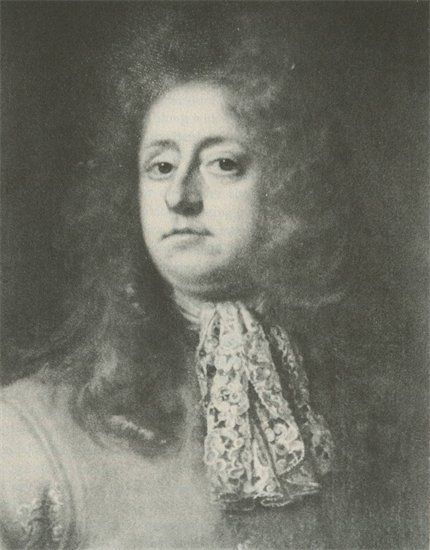
Detail from a portrait by John Closterman of Arthur Herbert, 1st Earl of Torrington, British admiral and politician. Circa 1700
English admiral. Born in 1648, Arthur Herbert was the third son of Sir Edward Herbert, attorney general to King Charles I. He joined the navy in 1663 and served with Sir Robert Holmes. He was at the Battle of Lowestoft on 3 June 1665, the Four Days’ Battle on 1–4 June 1666, and the St. James’s Day Fight on 25 July 1666.
Promoted to captain in 1666, Herbert served under Sir Thomas Allin in the Mediterranean. When Sir Edward Spragge replaced Allin in 1670, Herbert stayed with Spragge. Herbert took part in the attack at Bugia Bay on 8 May 1671, when he was wounded in the face by a pistol ball during a fight with an Algerine corsair.
Herbert played an active part in the leading battles of the Third Dutch War, among them Solebay on 28 May 1672 and the Texel on 11 August 1673. He served again in the Mediterranean under Admiral Sir John Narbrough between 1674 and 1675. In 1675 he was briefly dismissed from the navy, but he did not remain long out of favor and was restored to his commission in 1676.
In 1678 Herbert was appointed vice admiral to Sir John Narbrough in the Mediterranean. When Narbrough returned to England in April 1679, Herbert was left at Tangier with a small squadron of nine ships. He provided support to the garrison by landing sailors to strengthen the garrison and by digging and manning entrenchments.
In 1680 Herbert was appointed admiral of the Tangier fleet, and he successfully negotiated a peace treaty with Algiers in 1682. He also recognized the strategic importance of Gibraltar for cleaning English ships, and he used the place as a naval base for 18 months. Herbert returned to England in 1683 and served as a member of the Admiralty Board until 1684 when Samuel Pepys was reappointed. Herbert was appointed Master of the Robes by King James II in 1685 but was dismissed in 1687 when he refused on grounds of conscience to agree to the repeal of the Test Act.
In summer 1688 Herbert carried the invitation to William of Orange to invade England, and in November William appointed him to command the Dutch invasion fleet because of the support he had among the captains in the English fleet commanded by George Baron Dartmouth. In March 1689 Herbert became first lord of the Admiralty. On 1 May he fought the French fleet in the Battle of Bantry Bay. He was created earl of Torrington after the battle. He resigned from the Admiralty at the end of the year to protest the condition of the navy. As commander in chief of the Allied fleet, he was defeated by the French off Beachy Head on 30 June 1690 and was court-martialed and acquitted. William dismissed him from all his posts, and he never again served at sea.
From 1691 to 1715 Herbert was an active member of the House of Lords. He died on 3 April 1716, possibly at Weybridge, Surrey. He is buried in Westminster Abbey, although there is no memorial to him.
References
Davies, J. David. Gentleman and Tarpaulins: The Officers and Men of the Restoration Navy. Oxford, UK: Clarendon Press, 1991.
Ehrman John. The Navy in the War of William III. Cambridge, UK: Cambridge University Press, 1953.
Hornstein, Sari R. The Restoration Navy and English Foreign Trade, 1674–1688. Aldershot, UK: Scolar Press, 1981.
Le Fevre, Peter. “Arthur Herbert, Earl of Torrington (1648–1716) ‘A Fine Man’ Both in Courage and Conduct.’” In: Precursors of Nelson: British Admirals of the Eighteenth Century, ed. Peter Le Fevre and Richard Harding, 19–41. London: Chatham Publishing, 2000.